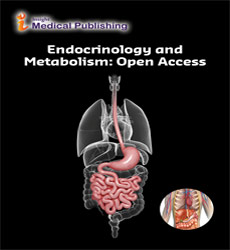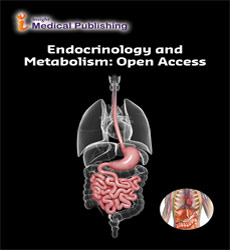Thyroid Hormone Resistance Syndromes: Genetic Insights and Clinical Challenges
Jana Alexander*
Department of General Medicine, Box Hill Hospital, Melbourne, VIC 3128, Australia
*Corresponding author:
Jana Alexander,
Department of General Medicine, Box Hill Hospital, Melbourne, VIC 3128, Australia,
E-mail: Alexander.jana21@alumni.imperial.ac.uk
Received date: February 01, 2025, Manuscript No. ipemoa-25-20739; Editor assigned date: February 03, 2025, PreQC No. ipemoa-25-20739 (PQ); Reviewed date: February 15, 2025, QC No. ipemoa-25-20739; Revised date: February 22, 2025, Manuscript No. ipemoa-25-20739 (R); Published date: February 28, 2025
Citation: Alexander J (2025) Thyroid Hormone Resistance Syndromes: Genetic Insights and Clinical Challenges. Endocrinol Metab Vol.09 No.1:02
Introduction
Thyroid hormone plays a central role in regulating metabolism, growth, development and energy homeostasis. Its actions are mediated through binding to nuclear thyroid hormone receptors, which control the transcription of numerous target genes. Disorders of thyroid hormone function are typically associated with either hypo- or hyperthyroidism, resulting from altered production, secretion, or regulation of thyroid hormones. However, a rare group of disorders, collectively termed thyroid hormone resistance syndromes, represent a distinct clinical entity in which end organs demonstrate reduced sensitivity to thyroid hormone despite normal or elevated hormone levels in circulation. These conditions are genetically heterogeneous, often resulting from mutations in thyroid hormone receptor genes or associated signaling pathways and present significant diagnostic and therapeutic challenges. With advances in molecular genetics and endocrinology, our understanding of these syndromes has deepened, yet many clinical complexities remain unresolved [1].
Description
Thyroid Hormone Resistance Syndromes (THRS) are most commonly caused by mutations in the Thyroid Hormone Receptor Beta (THRB) gene, although defects in Thyroid Hormone Receptor Alpha (THRA) and other regulatory factors have also been identified. Mutations in THRB account for the majority of cases and typically result in Resistance to Thyroid Hormone Beta (RTHβ), a disorder characterized by elevated circulating free Thyroxine (T4) and Triiodothyronine (T3) with nonsuppressed or even elevated thyroid-stimulating hormone (TSH).
The mechanism involves dominant-negative inhibition, whereby mutant receptors interfere with the function of wild-type receptors, leading to impaired thyroid hormone signaling at the tissue level. Patients with RTHβ often display a broad spectrum of clinical phenotypes. Some may present with features of hypothyroidism, such as fatigue, dyslipidemia and impaired growth, while others exhibit signs of hyperthyroidism, including tachycardia, hyperactivity and goiter. Many patients display a paradoxical mixture of hypo- and hyperthyroid features, reflecting tissue-specific variability in receptor expression and hormone sensitivity. For instance, the pituitary gland may demonstrate resistance, failing to suppress TSH secretion despite elevated thyroid hormone levels, while peripheral tissues remain sensitive, leading to features of hyperthyroidism. This variable presentation complicates clinical diagnosis and often leads to misclassification as primary thyroid dysfunction if genetic testing is not pursued [2].
Resistance to Thyroid Hormone Alpha (RTHα), caused by mutations in the THRA gene, is considerably rarer but increasingly recognized. Unlike RTHβ, this syndrome typically presents with normal or borderline thyroid hormone levels but reduced T3 activity in tissues predominantly expressing the THRA isoform, such as bone, gastrointestinal tract and central nervous system. Clinical manifestations include growth retardation, delayed bone development, constipation, bradycardia and cognitive impairment. Because standard thyroid function tests may appear within the normal range, RTHα is often underdiagnosed, underscoring the importance of genetic testing in patients with suggestive phenotypes. Beyond THRB and THRA mutations, other molecular mechanisms have been implicated in thyroid hormone resistance syndromes. Mutations affecting cofactors involved in receptor signaling, abnormalities in thyroid hormone transporters such as MCT8 and defects in hormone metabolism enzymes like deiodinases contribute to resistance phenotypes.
For example, Allan-Herndon-Dudley syndrome, caused by mutations in MCT8, presents with severe neurodevelopmental impairment due to impaired transport of thyroid hormone into neurons, despite elevated circulating T3 levels. Such disorders highlight the complex network of molecular interactions governing thyroid hormone action and the need for precision in diagnostic evaluation [1].
The genetic insights gained through advances in sequencing technologies have revolutionized the diagnosis of thyroid hormone resistance syndromes. Next-generation sequencing has enabled rapid identification of pathogenic variants, allowing for better genotype-phenotype correlations and improved recognition of atypical or mild cases. Moreover, functional studies have elucidated how specific mutations alter receptor structure, DNA-binding affinity and interaction with co-regulators. These findings not only expand our understanding of thyroid hormone biology but also provide opportunities for targeted therapeutic interventions. From a clinical standpoint, managing thyroid hormone resistance syndromes remains challenging. The primary therapeutic goal is not simply to normalize laboratory parameters but to alleviate symptoms and improve quality of life. Because TSH levels are often inappropriately elevated despite high thyroid hormone concentrations, attempts to suppress TSH with supraphysiologic doses of thyroid hormone may worsen symptoms in sensitive tissues and increase the risk of complications such as arrhythmias, osteoporosis and metabolic disturbances. Treatment decisions therefore require careful balancing of biochemical findings with clinical presentation [2].
Conclusion
Thyroid hormone resistance syndromes represent a fascinating and complex intersection of endocrinology, genetics and clinical medicine. Advances in molecular genetics have illuminated the diverse mechanisms underlying these disorders, ranging from receptor mutations to transporter and cofactor abnormalities. Yet, clinical management continues to pose challenges, given the heterogeneity of presentations, paradoxical laboratory findings and risks associated with overtreatment.
The integration of genetic testing into routine diagnostic workflows has enhanced recognition and enabled more precise classification, but therapeutic options remain limited, often focusing on symptom relief rather than curative intervention. Future directions in research include the development of selective thyroid hormone analogs, gene-targeted therapies and strategies to modulate receptor function, which may ultimately provide more effective and individualized treatment approaches. As our understanding of these syndromes continues to expand, the interplay between genetic insights and clinical practice will remain pivotal in improving outcomes for patients affected by thyroid hormone resistance.
Acknowledgement
None.
Conflict of Interest
None.
References
- Heymsfield SB, Wadden TA. Mechanisms (2017) Pathophysiology and management of obesity. N Engl J Med 376(3): 254-266.

Open Access Journals
- Aquaculture & Veterinary Science
- Chemistry & Chemical Sciences
- Clinical Sciences
- Engineering
- General Science
- Genetics & Molecular Biology
- Health Care & Nursing
- Immunology & Microbiology
- Materials Science
- Mathematics & Physics
- Medical Sciences
- Neurology & Psychiatry
- Oncology & Cancer Science
- Pharmaceutical Sciences
